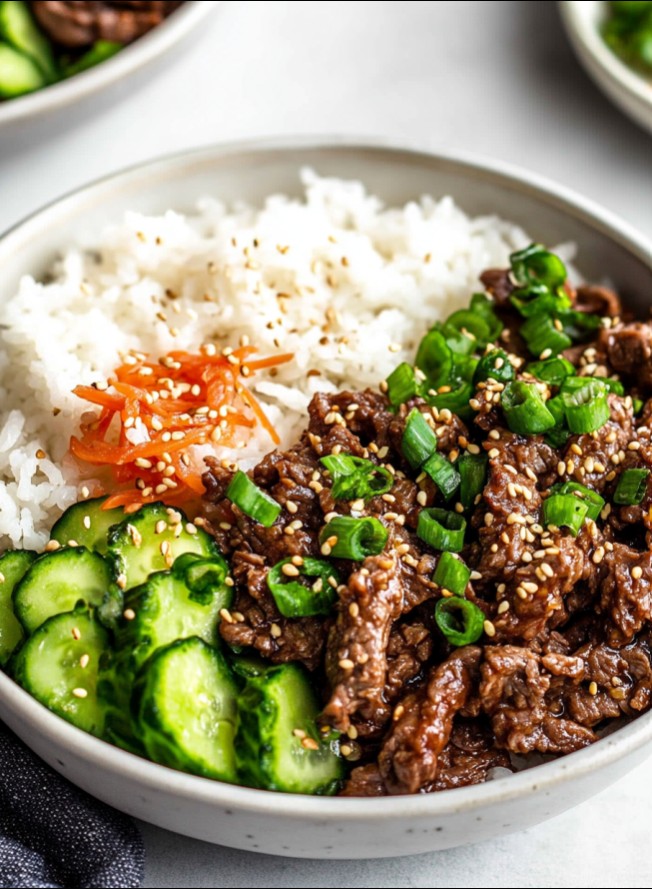This 15-Minute Korean Beef Bowl is your solution for a speedy weeknight dinner. With ground beef stir-fried in a sweet and savory bulgogi sauce, it’s a delicious way to bring Korean flavors to your table with minimal effort.

Save This Recipe! 💌
We'll email this post to you so you can cook it later!
- Cuisine: Korean
- Prep Time: 5 minutes
- Cook Time: 10 minutes
- Total Time: 15 minutes
- Servings: 4
Why You’ll Love This Recipe
- Quick and easy: Ready in just 15 minutes, perfect for busy weeknights.
- Minimal ingredients: Uses simple pantry staples with no obscure items.
- Customizable heat: Adjust the spice level with optional Korean pepper flakes and gochujang.
- Balanced flavors: Sweet, savory, and slightly spicy, bringing a taste of Korea to dinner.
Ingredients
- 1 lb ground beef: Provides a hearty, protein-rich base. Feel free to substitute with ground turkey or chicken.
- ¼ cup white onion (chopped): Adds mild sweetness and depth to the dish.
- 1 Tablespoon avocado oil: A neutral oil for sautéing; substitute with olive or canola oil if needed.
- 2 stalks scallions (chopped): Provides freshness and a mild onion flavor.
- 2 cups sesame broccoli (or plain steamed broccoli): A nutritious, crunchy side. Add sesame oil and seeds for extra flavor.
- kimchi (to serve on the side, optional): Offers traditional spicy and tangy flavor that complements the beef.
- sesame seeds (for garnish): Adds a nutty aroma and a bit of texture.
- steamed rice: The perfect base for soaking up all the flavorful sauce.
- 3 Tablespoons brown sugar (packed tightly): Balances savory notes with a touch of sweetness.
- 2 Tablespoons low sodium soy sauce: Provides saltiness and umami; use regular soy sauce if that’s what you have.
- 1 Tablespoon dark soy sauce: Adds color and depth; regular soy sauce can be a substitute.
- 1 Tablespoon sesame oil: Infuses a rich, nutty flavor; irreplaceable for authentic Korean taste.
- 2 cloves garlic (minced): Lends a pungent aroma essential to Korean cooking.
- 1 teaspoon ginger (grated): Adds warmth and a zesty kick to the sauce.
- ½ Tablespoon Korean red pepper flakes (optional for spice): Traditionally adds heat. Skip or adjust to taste.
- ½ Tablespoon gochujang – Korean red pepper paste (optional for spice): Deepens flavor and heat. Optional for those who enjoy spice.
How to Make It
Step 1: Prepare the Sauce
In a small bowl, combine all your sauce ingredients: brown sugar, low sodium soy sauce, dark soy sauce, sesame oil, garlic, ginger, and if you desire spice, add the red pepper flakes and gochujang. Whisk these together until the sugar dissolves, creating a smooth, well-blended sauce. This sauce will carry the dish with its balance of sweet and savory notes.
Step 2: Cook the Beef
Heat a tablespoon of avocado oil in a large pan over medium-high heat. Add the ground beef, breaking it into small pieces as it cooks. You’ll want to brown the meat thoroughly, which should take about 5 minutes. As it nears full cooking, toss in the chopped onions, letting them soften slightly. Pour in your prepared sauce, stirring to coat the beef evenly. Cook for an additional 2-3 minutes, or until the sauce has thickened slightly, deepening in color as it combines with the beef juices.
Step 3: Finish with Scallions
Turn off the heat and stir in the chopped scallions. The residual heat from the pan will slightly soften the scallions, bringing out their flavor while retaining their vibrant color and crunch.
Step 4: Serve
Spoon the saucy Korean beef over bowls of steamed rice. Accompany with sesame broccoli and, if desired, a serving of tangy kimchi on the side. Finish with a sprinkle of sesame seeds for visual appeal and extra flavor. Serve immediately to enjoy the contrasting textures and intricate flavors at their best.
Recipe FAQs
Can I use a different type of beef?
Absolutely. Ground turkey or chicken make great alternatives, especially if you prefer a lower fat option.
What if I don’t have gochujang?
If gochujang is unavailable, use more Korean red pepper flakes to maintain the spice. Alternatively, a small amount of Sriracha can provide heat and a touch of sweetness.
How can I make this dish gluten-free?
To make it gluten-free, ensure the soy sauces used are labeled gluten-free, or substitute with tamari.
Save This Recipe! 💌
We'll email this post to you so you can cook it later!






